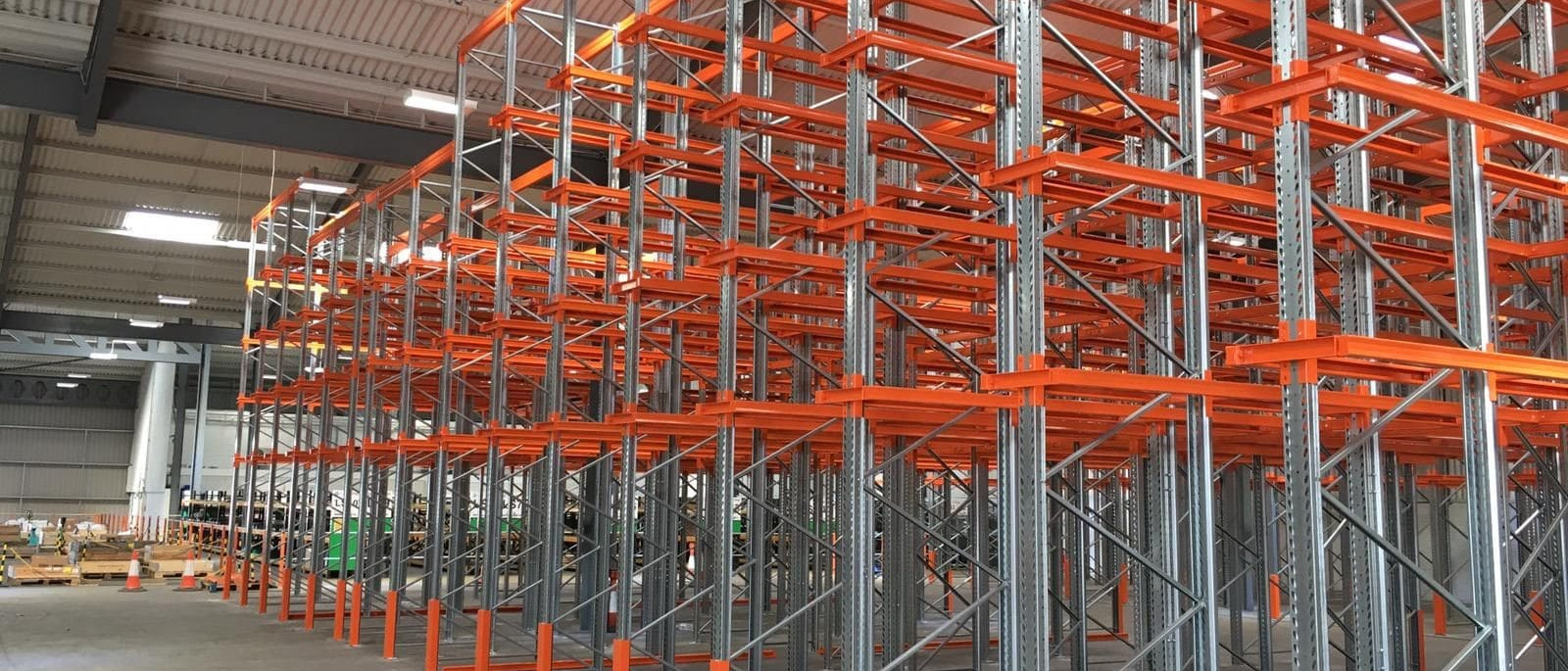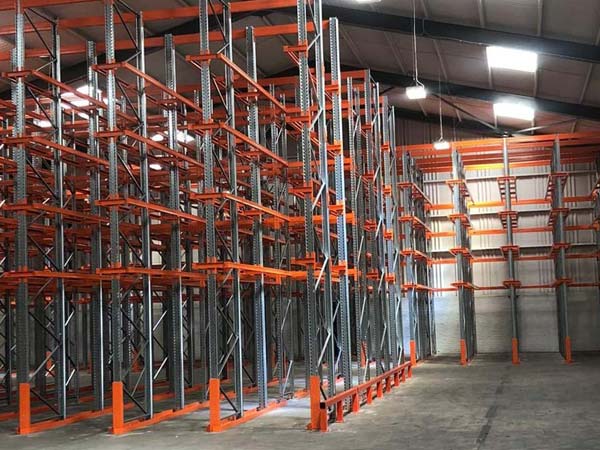Are you a warehouse manager looking to optimise space and increase efficiency in your facility? If so, you may want to consider drive in racking as a solution. This innovative storage system has been chosen by many businesses for its ability to maximise storage space while also offering significant cost savings.
What is a Drive In Pallet Racking?
Best suited for warehouses that handle high volumes of bulky items, Drive In Pallet racking systems are best suited for warehouses that handle high volumes of relatively bulky items. Drive-In Pallet Racking utilises vertical space efficiently by eliminating aisles between racks, allowing forklifts to drive directly into the racking bays to access the palleted goods. This design minimises wasted aisle space, making it an ideal choice for warehouses with a high volume of products.
So, what exactly is Drive In Pallet Racking, and why should you consider it for your warehouse operations? Let’s break it down in simple terms below…

Why Choose Drive In Pallet Racking for Your Warehouse Operation?
Choosing drive-in pallet racking for your warehouse operation brings many benefits, making it a compelling choice for businesses looking to optimise their storage space and enhance operational efficiency.
Here are several reasons why you should consider drive-in pallet racking:
- Maximised Space Capacity: Drive-in pallet racking systems typically have a higher storage density than traditional selective rack systems because they allow pallets to be stored closer together and with fewer aisles. This is possible because the system only requires one aisle for retrieval rather than two aisles as in a traditional pallet racking system.
- Cost-Effective: With drive-in pallet racking, every inch of floor space and can utilised so it makes it the ideal solution for businesses looking to optimise their space without the need for costly expansions or the need to locate to bigger facilities.
- Suitability for High Volume Inventory: Drive-in pallet racking is a great solution if storing large quantities of the same product or SKU. This makes it an ideal choice for warehouses with high-volume inventory that doesn't require frequent access, such as seasonal items or raw materials.
- Improved Accessibility: Drive-in pallet racking still provides relatively easy access to stored goods. Forklifts can drive in to the bay the and retrieve pallets from multiple positions, facilitating efficient loading and unloading operations.
- Safety and Durability: Drive-in pallet racking systems are built to withstand heavy loads and rigorous warehouse environments. With robust construction and adherence to safety standards, these systems ensure the safety of both your warehouse operative and the stored goods.
How does drive in pallet racking differ from conventional racking
Drive In Pallet Racking is all about making the most of vertical and horizontal space by eliminating the need for multiple aisles. Traditional pallet racking requires several aisles between rows to allow forklifts to retrieve goods. In contrast, Drive In Racking is configured for the forklifts to drive directly into the racks to access the pallets. This not only saves valuable floor space but also increases storage density, which is crucial for businesses handling a high volume of products.
Drive in pallet racking differs significantly from conventional racking systems, here’s how:
Storage Methodology: Conventional racking systems prioritise individual accessibility to each pallet location and the aisle between the racks allows for direct access to pallets, making it a great solution for fast-moving goods. However, hand, drive in pallet racking maximises the storage capacity by removing the aisles, enabling the pallets to be stored in-depth. This method is ideal for goods with lower turnover rates, as it prioritises bulk storage and available space.
Accessibility: In conventional racking, forklifts drive through aisles to access the pallets to quickly and efficiently pick the stock. This design requires enough space between racks to able the forklift to move, which limits storage capacity. Whereas Drive-in pallet racking allows forklifts to drive directly into the racking structure, accessing multiple pallets within each bay. While this method reduces accessibility to individual pallets, it significantly increases storage density, making it ideal for warehouses with limited space.
Inventory Management: Conventional racking systems are a good choice for first-in, first-out (FIFO) inventory management, where older stock is accessed before newer stock as access to the pallet positions is much easier. Drive-in pallet racking, on the other hand, is better suited for last-in, first-out (LIFO) inventory management, where the most recently stored pallets are accessed first. This is because pallets are stored in-depth, with newer stock positioned behind older stock, requiring forklifts to retrieve pallets from the rear of the rack.
Space Utilisation: Conventional racking systems typically require wider aisles between racks to accommodate forklift maneuverability, resulting in lower storage density. Drive-in pallet racking maximises the vertical space in the warehouse by removing the aisles and allowing forklifts to access pallets within the rack structure. This design significantly increases storage capacity, making it ideal for warehouses looking to make the most of limited floor space.
Flexibility: Conventional racking systems offer greater flexibility in terms of SKU selection and rotation, as each pallet position is individually accessible. Drive-in pallet racking, while highly efficient for bulk storage of homogeneous goods, may be less flexible when it comes to SKU rotation and access to specific pallets. However, it can still accommodate varying pallet sizes and configurations within its design parameters.

When should you consider drive in racking?
With various pallet racking systems available, you should consider if Drive-In Racking is the best choice for your warehouse operations. Here are some scenarios where this system excels:
- High-Volume, Low-SKU Inventory: If your warehouse stores large quantities of a few types of products, Drive In Racking can provide significant benefits in terms of space and operational efficiency.
- Bulk Goods or Seasonal Stock: Warehouses dealing with bulk goods or seasonal products that are stored for extended periods can greatly benefit from this racking solution. It’s also excellent for cold storage applications, where maximising space is essential.
- Limited Space: If your warehouse is limited in size or expanding the facility isn’t an option, Drive-In Racking helps you store more in less space.
Things to keep in mind
While Drive-In Pallet Racking offers numerous benefits, there are some factors to consider to ensure it’s the right fit for your business needs:
- Forklift Training: Since forklifts are required to drive into the racking bays, operators need proper training to navigate these lanes safely and efficiently.
- Load Stability: The system depends on pallets being securely placed on the rails. It’s crucial to use pallets of uniform size and weight for optimal stability and to prevent accidents.
- Inventory Management: Drive-In Racking works best with LIFO inventory systems. If your goods require a strict First-In, First-Out (FIFO) approach, you might want to explore alternative racking solutions like Drive Through Pallet Racking.
Drive In vs. Drive-Through Pallet Racking: What’s the Difference?
At this point, you might be wondering about Drive-Through Racking. While both systems sound similar, there’s a key distinction: Drive-Through Racking allows forklifts to access both ends of the racking system, enabling a FIFO inventory flow. This is beneficial for perishable goods or products that require more stringent stock rotation.
Drive In Racking, on the other hand, only permits entry from one side, making it perfect for goods that can be managed using a LIFO approach.
Making the right choice when it comes to pallet racking is the first step in optimising the use of a warehouse. This requires a deep understanding of warehouse space and knowing which areas to optimise, where to add or remove, and what is most efficient. By contacting the team at Stamina Storage Solutions, we can help you make the right decision for your business. To speak to our team, or arrange a free site visit, get in touch today.
